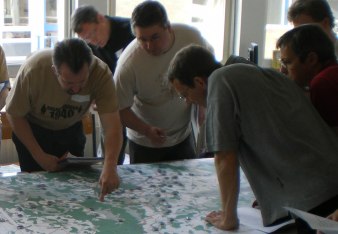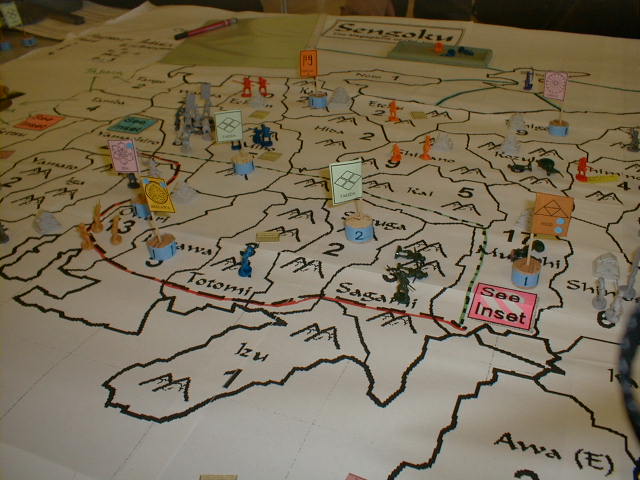Turning ‘Shogun’ into a megagame.
Sengoku the megagame of classical Japan.
Japanese history has been a long term interest of mine, and when I first played the board game ‘Shogun’ I was very impressed at the way it captured the flavour of the age of civil wars, the Sengoku-jidai. It looked like this would be an excellent way of introducing the subject via a megagame. 
The original board game has a lovely simplified map of provinces, and hundreds of plastic toy soldiers with which to represent armies as well as tiny model castles, swords, game money and so on. The components themselves were inspirational.
Of course, I would be turning a 5 player game into a 40 or 50 player game and so some changes would be necessary. It turned out that a lot of change was necessary – so much so that now nothing of the original game’s structure or mechanisms remains in the current iteration of the Sengoku megagame.
The first thing was to identify the player teams and this was the first major change. I wanted to set the game in a specific time and chose 1551 as a good starting point. It became clear who were the leading clans of this time, and I was able to create teams of players based on the historical diamyo and their families, and create briefings of ‘recent’ historical events based on the real world of the period. In doing this it became clear that the economic values allocated to the provinces in Shogun were not quite right, so I reset that data using actual rice taxation levels from 1551. This made quite a difference and whilst it would have created an unbalanced board game, it was a distinct benefit in a megagame which thrive on unbalanced scenarios and it made this historical feel a good deal better – once the wealth of provinces was taken into account it was pretty clear why certain clans came to the fore (and why some clans were never deafeated).
To further the sense of historical feel, the teams needed much more than just decisions about raising armies and marching them about to conquer areas on the map to properly reflect life int he period.
Drawing on my experience developing role playing games set in the period it was obvious to me that the core of the game would be the dynamic within the clan as much as it would be about rivalry and conflict between clans. Japanese samurai society contains a wealth of inter-related individuals, complex clan and obligation networks and this would form a basis for the team sub-game. I also wanted to introduce a high degree of Japanese culture of the time including the formal nature of relations, the rituals, and something of the mood and attitude of the time.
 To achieve this I developed individual briefings for each player in the game explaining their relationship to others and their individual objectives. Watching over each clan team would be a Team Control who would be acting as GM for the team and allocating awards in the form of ‘culture points’ for good role playing and acting in accordance with some basic rules of etiquette selected for the game. This was entirely new and not part of the board game.
To achieve this I developed individual briefings for each player in the game explaining their relationship to others and their individual objectives. Watching over each clan team would be a Team Control who would be acting as GM for the team and allocating awards in the form of ‘culture points’ for good role playing and acting in accordance with some basic rules of etiquette selected for the game. This was entirely new and not part of the board game.
The board game had a neat and simple system of die rolling for battles, and in the early versions of the megagame I used something based on this. But it became clear that this took far too long, and by the second iteration I had a much more streamlined system that could be resolved quickly enough that it did not hold up the rest of the game. Of course, fromt he very start the megagame also had moved away from the IGYG game turns of the original and introduced simultaneous actions, based on written instructions where it was important.
It was also important to add in institutions like the main warrior monk temples (major political actors in the period) and the role of the Imperial Court and Nobility as well as the Bakufu (the shogun’s civil service).
By the time all the various teams, structures, streamlined systems and detailed briefings had been added the resulting game bore no resemblance to the board game that inspired it except for having a similar-looking game map of Japan. And there are only so many ways you can draw a province map of Japan so even that changed.
In retrospect the game could probably have been developed from scratch more easily, and with much the same end result (or even better). What is important here is that the prototype board game was a template to start the design process going. Even if you end up discarding absolutely everything of the original game (and be prepared to do this) having something to start with really helps, especially with your first megagame designs.
In Conclusion
There have been many cases over the years where a board game or even computer game have provided the baseline on which to develop.
The ultimate example of this would be the influence of the computer game UFO: Enemy Unknown (also know as XCOM and its successors) on the inception of the successful Watch The Skies series – whihc was inspired by the ideas of the much loved original computer game, but has ended up in a very different place.

The important part about converting a game into a megagame is be prepared to throw out anything that doesn’t work in the megagame context. Much loved mechanisms, structures, map, components – anything – if it doesn’t serve your megagame discard it. A megagame is a thing on its own, inspired by other games, or fiction or history or life, it still has to work as an experience for the players as well.
 published in the UK as ‘Greek Naval Warfare’). This is a tactical wargame where each player takes control of a small number of ancient Greek warships and aims to outmanoeuvre her opponent and ram and sink the enemy fleet. The game is built around a set of wargame rule that take account of differing sizes of Greek warship, the presence or marines and archers and the effects of ramming from different directions hitting more vulnerable parts of enemy vessels.
published in the UK as ‘Greek Naval Warfare’). This is a tactical wargame where each player takes control of a small number of ancient Greek warships and aims to outmanoeuvre her opponent and ram and sink the enemy fleet. The game is built around a set of wargame rule that take account of differing sizes of Greek warship, the presence or marines and archers and the effects of ramming from different directions hitting more vulnerable parts of enemy vessels.







